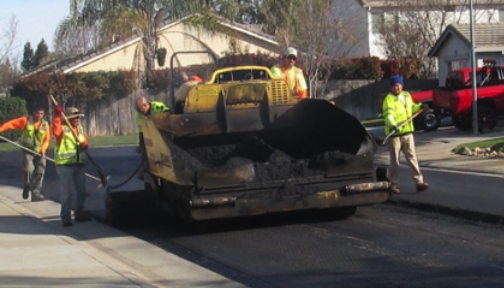Hot Mix Asphalt: The Foundation for Safe and Secure Angled Parking Lots
Hot Mix Asphalt: The Foundation for Safe and Secure Angled Parking Lots
Blog Article
Opening the Secrets of Hot Mix Asphalt Technology
Checking out the midsts of warm mix asphalt technology uncovers a globe where specific solutions and thorough processes converge to form our roadways and framework. The blend of fillers, binders, and accumulations isn't simply a building job yet a tactical orchestration of toughness and effectiveness. As we peer into the elaborate dance of parts, a tapestry of durability and sustainability unravels. What exists under this surface area of asphaltic mastery, and what keys wait to be introduced in the realm of leading technologies?
Value of Hot Mix Asphalt
Hot Mix Asphalt plays an essential role in modern-day infrastructure advancement as a result of its toughness and cost-effectiveness. As the most frequently utilized paving material for roadways, highways, and parking area, Hot Mix Asphalt provides a series of benefits that add to its importance in building tasks. One essential advantage is its capacity to endure rush hour loads and extreme weather conditions, supplying a dependable and resilient surface area for transportation networks. Additionally, Warm Mix Asphalt is cost-efficient in both initial building and long-lasting upkeep, making it a preferred choice for many infrastructure jobs.
The resilience of Hot Mix Asphalt stems from its make-up, which consists of aggregates, binder, and filler products that are thoroughly selected and blended to satisfy specific efficiency requirements. In general, the importance of Warm Mix Asphalt in facilities growth can not be understated, as it continues to be a foundation of contemporary construction techniques.
Components of Asphalt Mixes
The structure of asphalt mixes is composed of carefully picked accumulations, binder, and filler materials that are important for attaining specific performance needs. Aggregates are the key part of asphalt mixes, offering stamina and security. The binder, normally bitumen or asphalt cement, holds the accumulations together and offers versatility and longevity to the mix.
The mix and percentage of these parts play a significant role in identifying the high quality and performance of the asphalt mix. Designers carefully develop the mix to satisfy details demands, taking into consideration variables like website traffic quantity, climate problems, and sidewalk lifespan. Proper option and harmonizing of accumulations, binder, and fillers are crucial for developing sturdy, resilient asphalt sidewalks.
Mixing and Production Techniques

Once the aggregates are selected, the binder, typically asphalt concrete, is contributed to bind the products together. The binder's quality and quantity considerably impact the mix's versatility, resistance, and strength to ecological aspects. Furthermore, fillers like hydrated lime or Portland cement might be included to enhance specific characteristics of the asphalt mix, such as its workability or dampness resistance.
Throughout manufacturing, the aggregates and binder are heated, commonly in between 250-325 ° F(121-163 ° C ), to assist in mixing and ensure correct layer of the aggregates. The mixing process should be extensive to achieve an uniform combination that advertises the preferred performance features of the asphalt. Different techniques, such as set blending or drum mixing, are used to accomplish top notch and consistent asphalt blends for building projects.
Variables Impacting Asphalt Performance
Variables influencing asphalt performance incorporate a range of variables that influence the sturdiness, long life, and overall quality of asphalt sidewalks. One vital factor is the high quality of products made use of in the asphalt mix.

Ecological conditions also influence asphalt performance. Temperature level variations, dampness infiltration, and website traffic loads can all influence the structural stability of the sidewalk. Layout considerations, such as pavement thickness and water drainage, are vital in ensuring the long-lasting efficiency of the asphalt sidewalk. By very carefully taking into consideration these professionals, designers and aspects can maximize asphalt efficiency and boost the service life of pavements.
Sustainable Practices in Asphalt Innovation

In addition, the growth of warm-mix asphalt (WMA) modern technologies has actually gotten traction in recent years. WMA enables the production and positioning of asphalt blends at lower temperatures compared to traditional hot-mix asphalt, resulting in lowered energy usage and greenhouse gas emissions. The usage of porous asphalt mixes can aid mitigate stormwater drainage issues by permitting water to infiltrate via the sidewalk and into the ground, advertising natural water filtration and recharge procedures. By executing these lasting methods, the asphalt industry can add to developing a much more eco-friendly and resilient facilities network.
Final Thought
In verdict, warm mix asphalt technology plays a vital duty in modern-day infrastructure growth due to its sturdiness and cost-effectiveness. By meticulously balancing components, employing proper mixing techniques, and considering various elements, engineers can produce top quality asphalt mixes that endure rush hour lots and rough climate condition. Welcoming lasting practices, such as utilizing recycled products and warm-mix innovations, further enhances the ecological kindness of asphalt modern technology.
Mixing and production methods in warm mix asphalt modern technology entail the exact combination and processing of accumulations, binder, and fillers to develop a high-performance and resilient asphalt mix.Factors affecting asphalt performance encompass an array of variables that affect the toughness, durability, and total top quality of asphalt pavements. Lasting methods in asphalt innovation incorporate different campaigns click here for more intended at decreasing the environmental influence of asphalt production and paving procedures. By integrating reclaimed asphalt sidewalk (RAP) and recycled asphalt shingles (RAS) right into new asphalt mixes, the industry can significantly minimize the usage of raw materials and power, while also lowering landfill waste.
WMA permits for the production and positioning of asphalt blends at lower temperature levels compared to standard hot-mix asphalt, resulting in reduced energy intake and greenhouse gas discharges.
Report this page